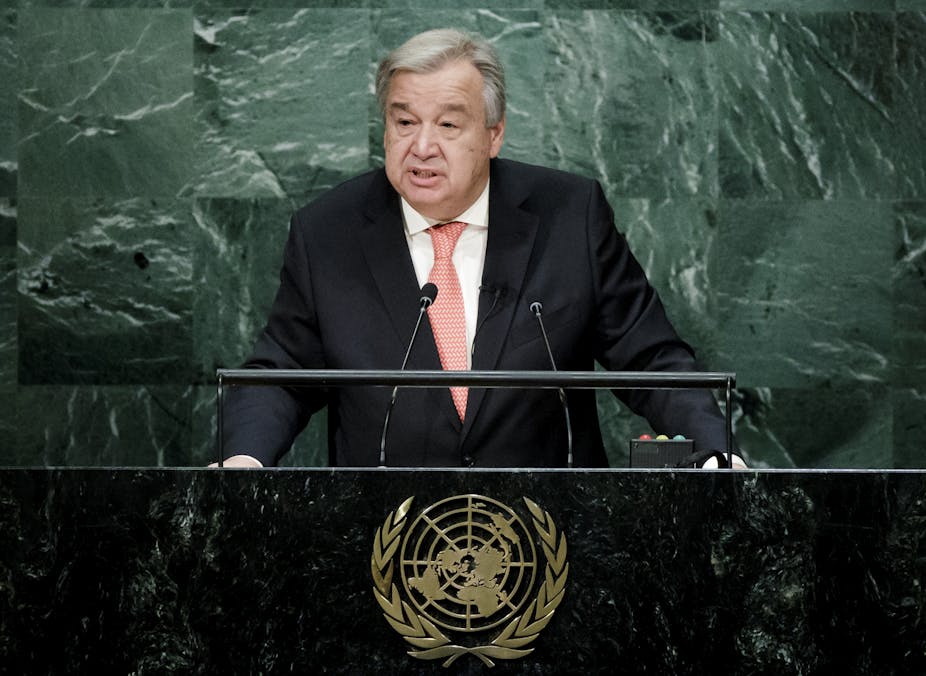As António Guterres takes over as the ninth secretary general of the United Nations, he inherits some of the most pressing global and institutional issues ever to confront the organisation. Given his background, which includes being prime minister of Portugal from 1995-2002 and then the UN’s High Commissioner for Refugees (UNHCR) from 2005-15, he certainly has the skills and experience he will need to shepherd the UN through years to come, and to reassert the authority the UN needs to protect the most vulnerable in times of international crisis.
But now he’s formally started the job, what’s he actually supposed to do? Some of the job description is laid out in the UN Charter: working as the organisation’s “chief administrative officer”, with and for the UN’s main organs, reporting annually to the General Assembly, and drawing the Security Council’s attention to any matter that threatens international peace and security.
The crucial point about the secretary general is that they must not be influenced by any government, and that no government may seek to influence them. The secretary general does not and should not have the powers of a president or a prime minister: their role is to be a masterful diplomat, working mostly behind the scenes. Above all, they should seek to ensure that all member states uphold the the purposes and principles of the UN and the rule of law so that every individual in the world has the greatest opportunity to reach their full potential. That is what international peace and security and respect for human rights make possible, and it’s ultimately the UN’s core mission.
Whether that mission will succeed in 2017 is another matter.
As Donald Trump’s presidential inauguration looms, the US and Russia look set to soften their working relationship after a decidedly rocky end to the Obama years. But while a little more cordiality could defuse a fair bit of tension and gridlock in the Security Council, these two governments’ shared worldviews may not respect the values the UN Charter is designed to uphold. Russia, for example, supports separatist movements in Georgia and Ukraine; Trump’s call for a wall along the Mexican border would prevent people fleeing persecution from reaching the US contrary to the country’s international obligations.
The fear is that the two superpowers will simply overlook each other’s infractions of international law, as well as other states’. China’s assertive behaviour in the East and South China seas, for instance, seem to be low on Trump’s agenda despite the US’s treaty obligations in the region.
All this is more or less uncharted territory. To make things more difficult, over the last few years, various powerful non-state groups (such as the so-called Islamic State) have emerged to challenge the Westphalian, nation state-based world order that the UN is fundamentally set up to protect. This is a huge organisational and political challenge, and it isn’t going away.
The UN has long experience of dealing with armed opposition groups in single states. But cross-border groups such as Islamic State and Boko Haram demand an altogether different approach, one that has to move away from simply seeking to uphold territorial integrity. Guterres’s challenge, then, is nothing less than helping the organisation to outgrow its roots in the very different postwar order of the 1940s.
Choreographer-in-chief
As I have previously written, some of the issues on his desk will feel very familiar from his UNHCR tenure. There is, after all, another global challenge at the top of the UN agenda: helping the 60m people the world over who are still forcibly displaced from their homes, with many more likely to join their ranks.
UNHCR has a tough year ahead, but Guterres is well placed to facelitate its work. There are two things to focus on: upholding the rights of displaced persons from the outset, and working with other parts of the UN family to come up with durable solutions to refugee crises everywhere. The way the UN is changing means he has his work cut out here too.
Now working alongside UNHCR is a new member of the UN family: the International Organisation for Migration (IOM), which has a mission to facilitate migration rather than provide refugees with protection. This is just right for much of the global north, which increasingly wants to stem the influx of asylum seekers and is happy to work with a body that moves migrants of whatever description on, rather than resettling them or integrating them locally – even if that would serve them best. Yet any solutions must still guarantee protection under UNHCR’s international mandate.

To be sure, in protracted situations, refugees and IDPs may become migrants too, but regardless of IOM’s increasingly prominent role, they never technically leave UNHCR’s protection. Guterres knows how vital this principle is, however keen some of the world’s richer countries might be to see people treated as migrants rather than refugees.
In maintaining international peace and security, the protection and promotion of human rights and upholding the rule of law by all, Guterres must also work hard to retain the support of the Security Council’s five permanent members – chief among them China, Russia and the US.
If he takes an interventionist line on any number of matters, he will inevitably challenge those states’ interests. And while he may have been appointed by the General Assembly, that only happened on the Security Council’s recommendation. He may only just have been confirmed, but if he wants to endure in the role, his diplomatic and political skills will need to be to the fore.
Faced with a global refugee crisis, a realignment among the great powers and the rise of dangerous non-state forces, the UN’s 193 member states must be carefully choreographed as never before. Guterres seems to be up to the job, but it could scarcely be more daunting.

